One of the good and easy ways to consume probiotics regularly is by including curd or dahi (yogurt) in our everyday meals. Curd has been a classic food in India for thousands of years. With this post, learn to make Indian Yogurt easily at home. This Curd recipe also mentions one of the traditional ways of preparing curd at home, by the fermentation process. There’s a list of tips in the end to deal with troubleshooting of this Dahi recipe. You can’t miss on that too.
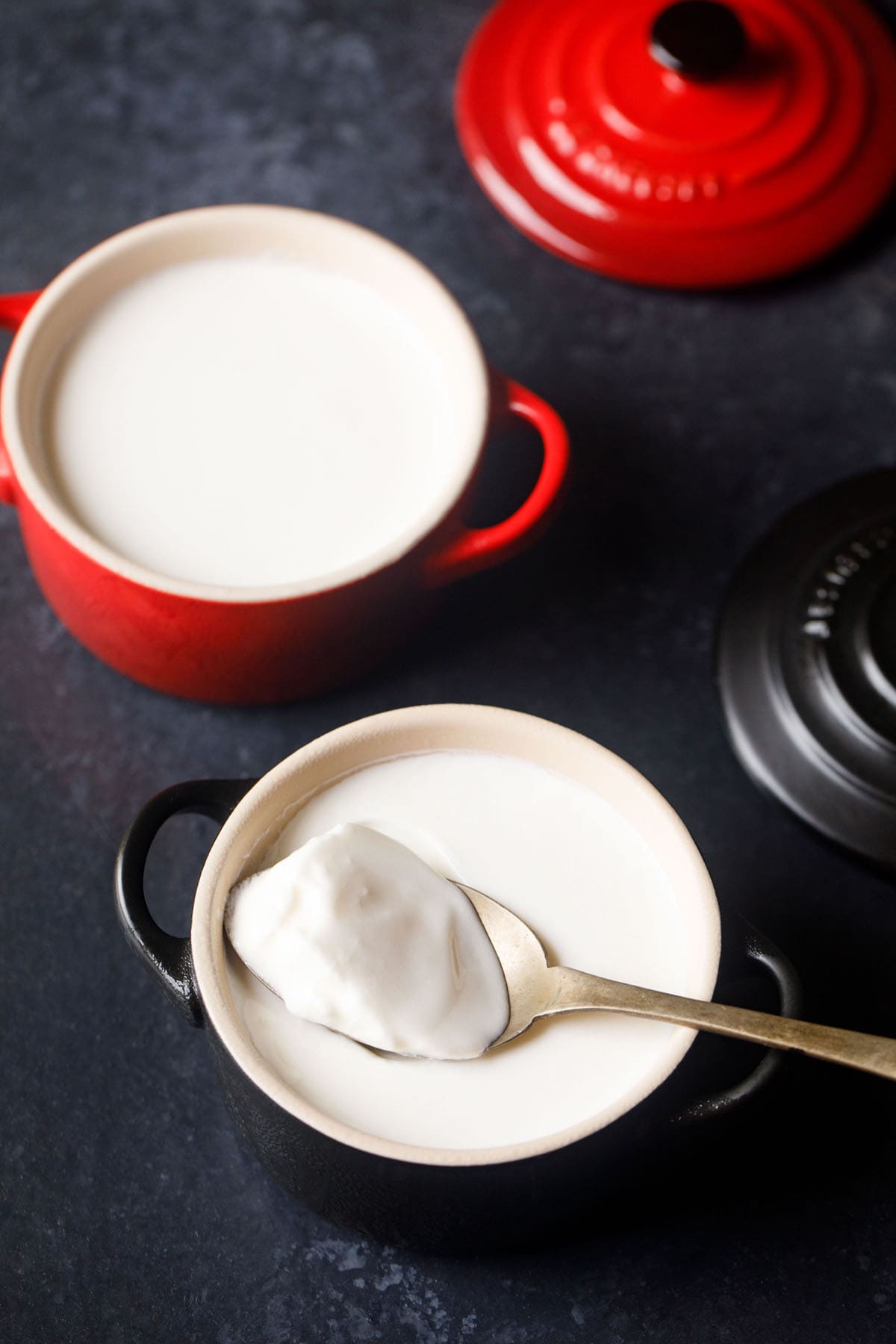
About Curd or Dahi
Curd or dahi, as it is known in Hindi, is a fermented milk product having its origins in the Indian subcontinent. The word ‘dahi’ is probably derived from the Sanskrit word ‘dadhi’ which means sour milk.
It is made by mixing a friendly bacterial yogurt starter with warm milk, which is then allowed to ferment for some hours.
Once the fermentation stage is completed, what you get is a thick, wobbly and pudding-like textured product, which the flowing milk transforms itself into.
And because there’s a fermentation process which includes bacteria, the resultant curd has a tangy taste too. Have been searching for the best answers on making curd at home, this is where your search ends!
Table of Contents
Basically, with this Dahi recipe, you get a fermented milk product that is healthy, gut friendly and probiotic in nature. This dahi can be further used to makes a variety of dishes in Indian as well as western cuisines.
The Curd Recipe yields dahi, which can also be called as the Indian Yogurt. However, know that the yogurt available outside India is quite different than the curd, of Indian origin or what is made in Indian households.
I’d been getting the most requests on sharing posts on this and even homemade paneer. While you are trying to make curd with this Dahi recipe, go for the homemade paneer with this How To Make Paneer tutorial.
I haven’t dived deep into the food science of making dahi and the fermentation process that this Curd recipe mentions. Have kept it quite basic. Understandable and doable by one and all. It also has a few tips that will help you master the art of making homemade curd.
Also, got friends who are struggling and having a tough time making fresh dahi at home? Share this post with them and make their lives easier. This Dahi recipe is quite the fool proof one that one can refer to easily.
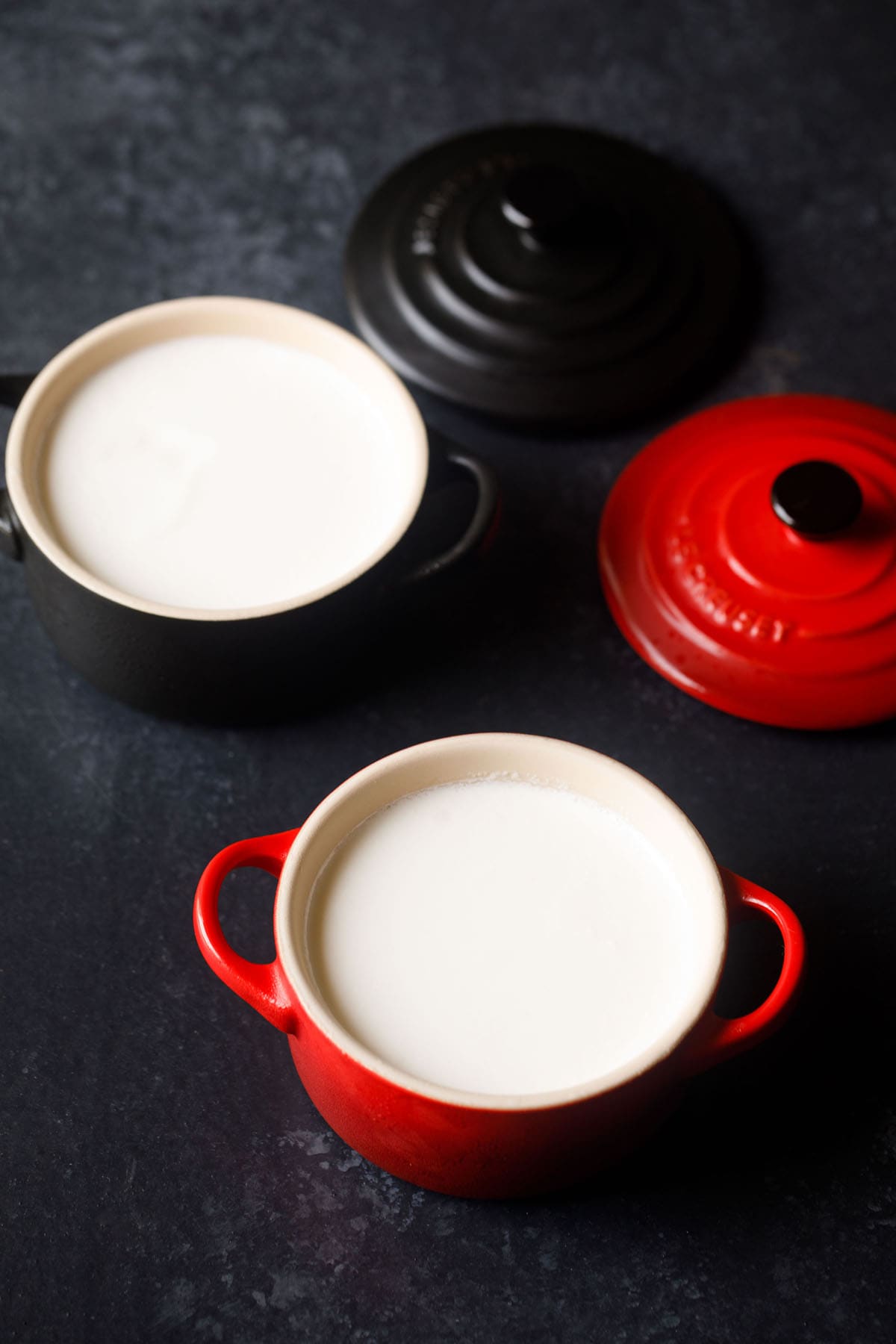
How to make Curd
Boil Milk
1. First step is to take a thick bottomed pan and rinse it with clean water.
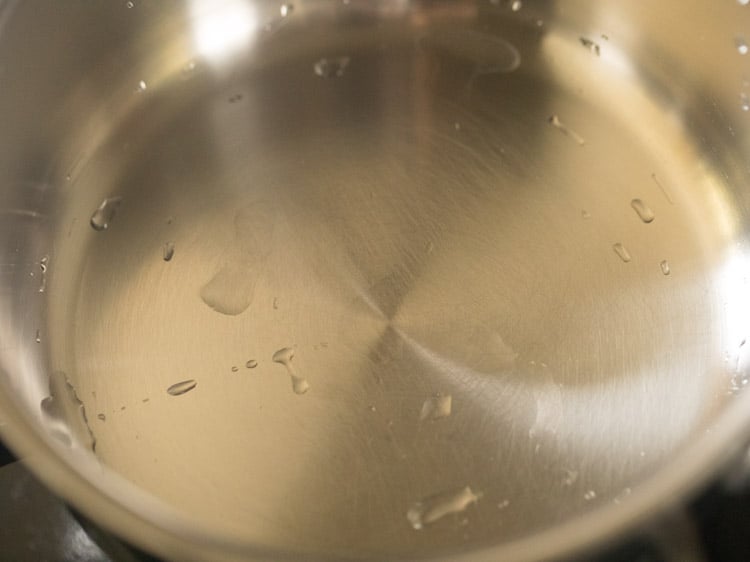
2. Then, add ½ liter (about 2 cups) whole milk. Keep the pan on the stovetop and begin to heat the milk on low to medium-low heat.
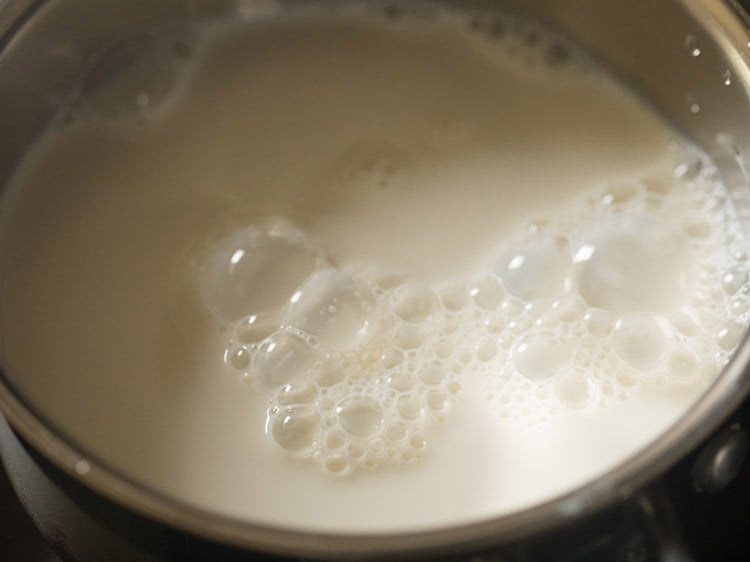
3. Stir the milk once or twice while it is heating, to avoid burning or browning from the bottom.
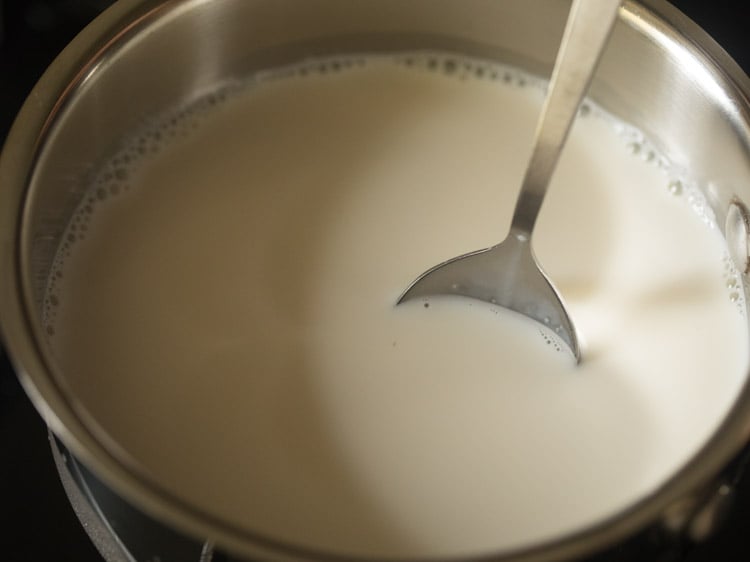
4. Let the milk come to a boil. Milk will froth and bubble when it comes to boil.
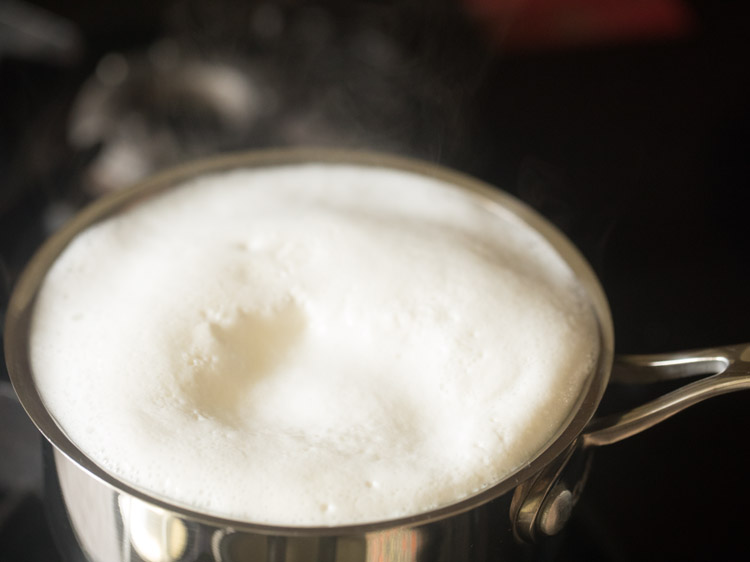
5. You can even heat milk to a temperature between 85 to 96 degrees C or 185 to 204 degrees F. If you have a food temperature scale then you can make use of it.
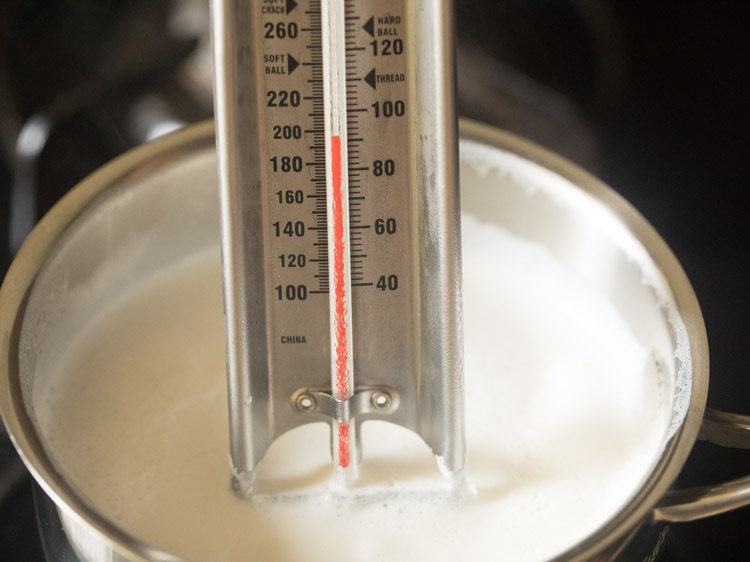
6. Turn off the heat. Remove the pan and keep it aside on the kitchen counter for the milk to cool to room temperature.
We only need the temperature of milk to reduce until the milk becomes warm.
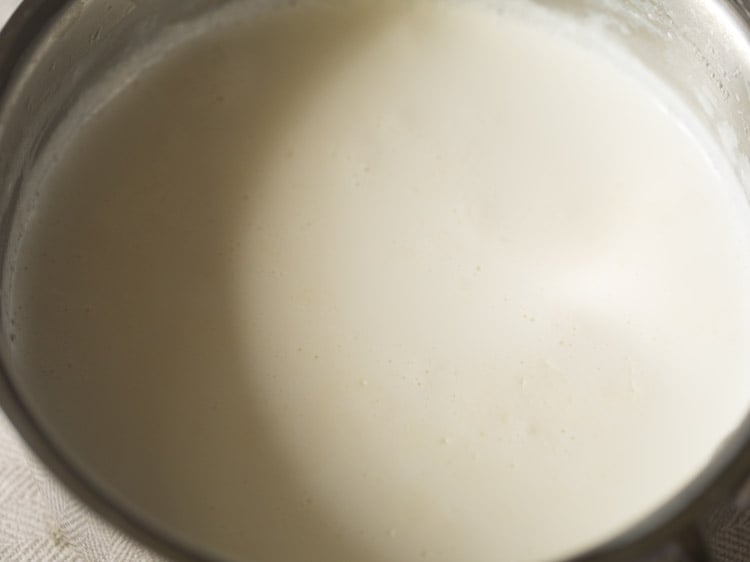
Ways to check if the milk is warm
7. You can check if the milk has become warm with your fingers (touch method) or with a thermometer. Dip your little finger in the milk and you should feel warm and not hot.
Another way is to touch the pan. When you touch the pan, it should feel warm and not hot.
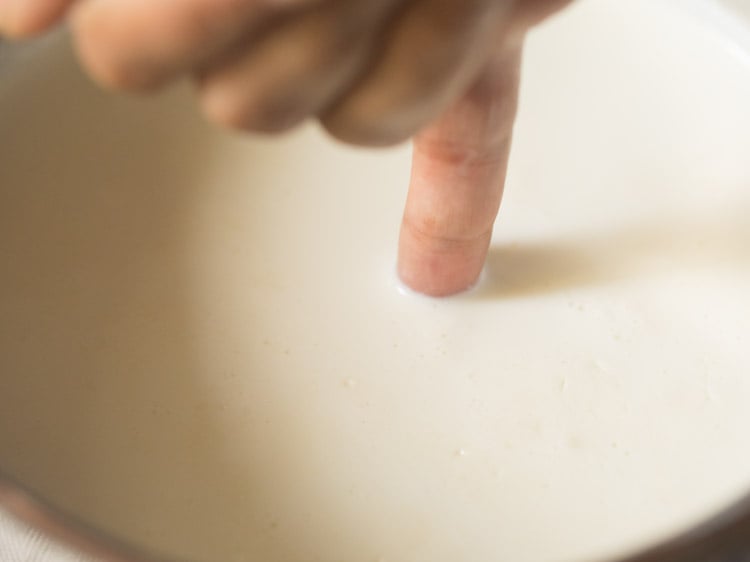
8. You can even use a food thermometer to check the temperature. The temperature of the warm milk should be between 39 to 44 degrees C or 102 to 111 degrees F.
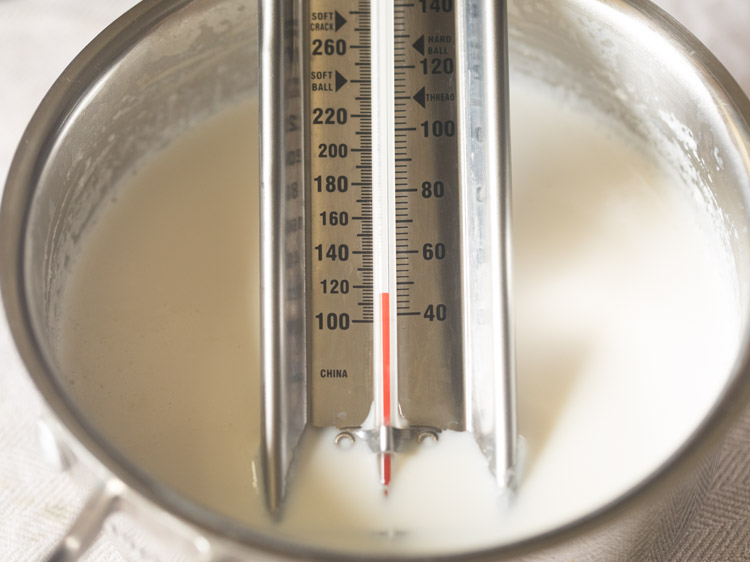
Adding Starter
9. Now, take 1 to 2 teaspoons of the curd starter and add in the warm milk. In winters, you can add 2 teaspoons. Whereas in summers, 1 teaspoon works fine.
Here I have used a leftover curd starter. Nowadays, you also get dry starters in super markets and online stores. So you can use these package starters also.
There are many types of starters available to make different kinds of yogurt. Choose the starter for the kind of yogurt you are planning to make.
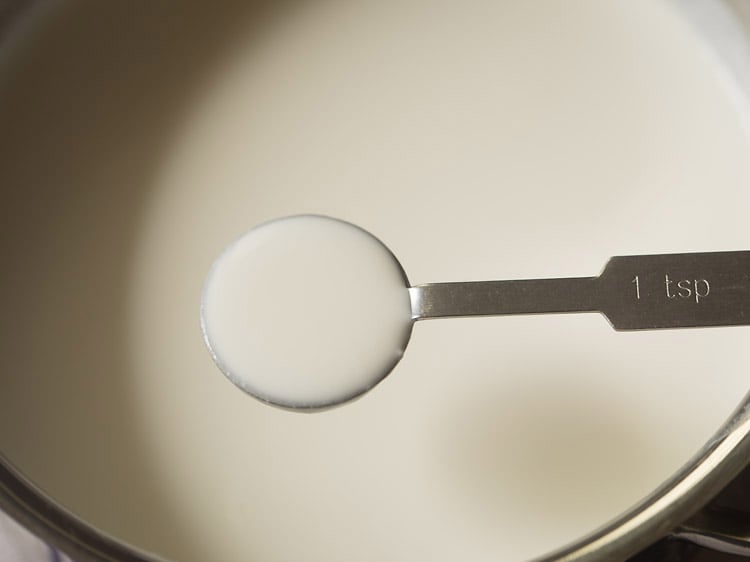
10. With a small wired whisk or a spoon mix very well. A small wired whisk makes the job of mixing the curd starter very well in the milk.
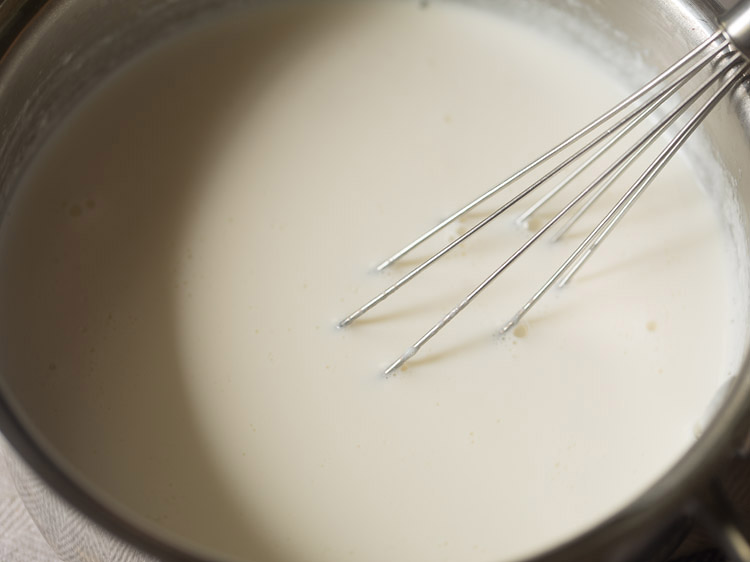
Setting Curd
11. Then, pour this mixture in a bowl or pan.
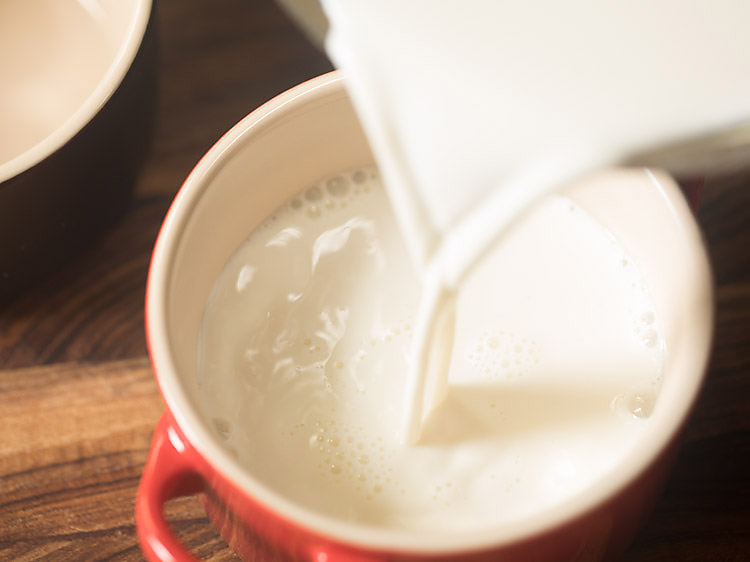
12. You can use terracotta, clay, steel, glass or ceramic bowls for setting the curd. To put less efforts, set the curd in the pan which was used to boil the milk.
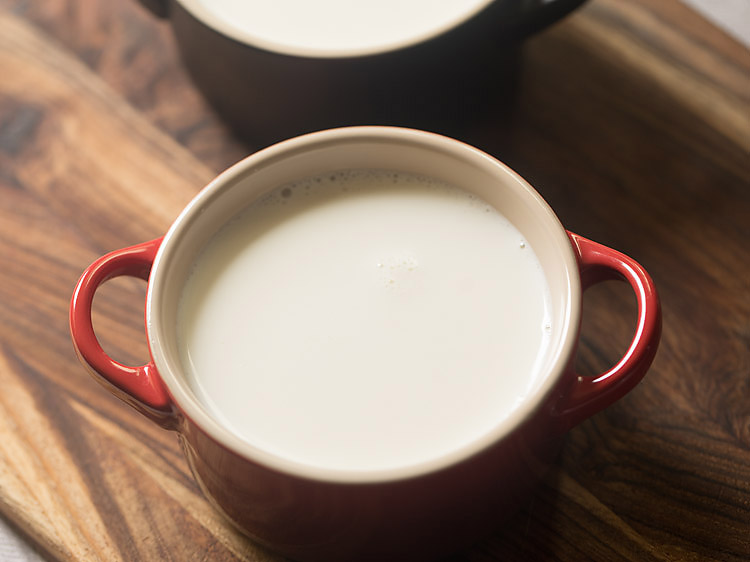
13. Cover with a lid and keep the curd to set. This is at room temperature for 4 to 5 hours. You can also keep overnight also. I kept overnight.
The time that the milk takes to convert into curd depends on the temperature. In a warm, hot and humid climate, the time taken for the curd to set will be 4 to 7 hours. Whereas in a cool or cold climate, the time taken can be 8 to 12 hours.
Nowadays, I also set the curd in the Instant Pot using the yogurt function. So if you have an Instant Pot, read the instructions to set the curd in it. Using it is very helpful if you live in a place with cold climate or during winters.
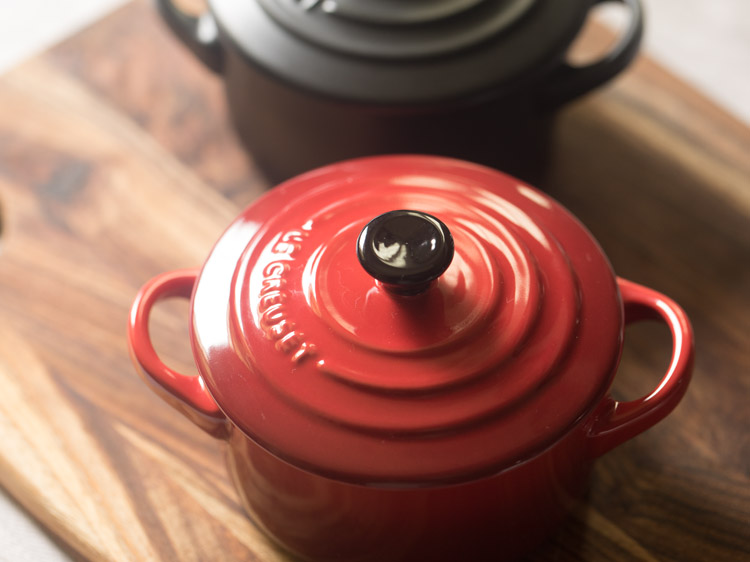
14. Next day, you will have nice well set homemade curd.
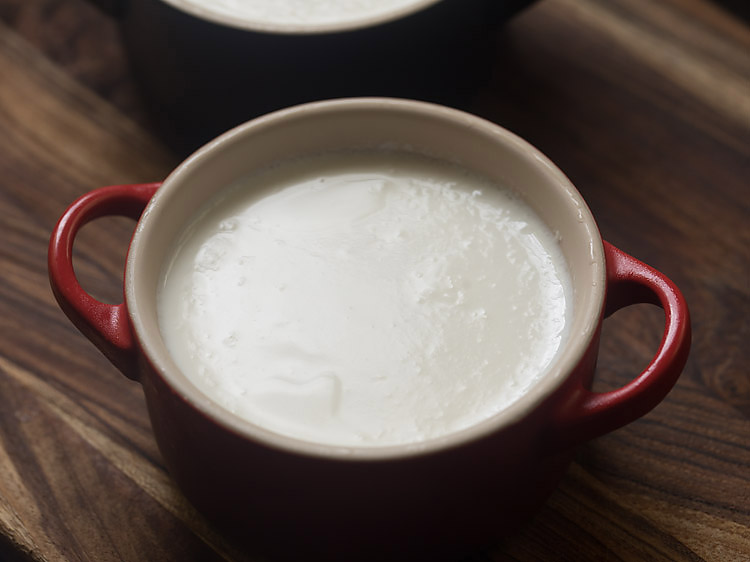
15. You can see in the below picture that its a properly set, thick and creamy curd. Usually, you see such thick curd in halwai shops (Indian sweet shops).
On fermentation, the curd will have a wobbly thick texture, pleasant fermented aroma and a slightly tangy taste. Remember to refrigerate it so that it does not get over fermented.
For any recipe, if you require sour curd, then keep it for a couple of hours more at room temperature. This will increase the sourness in the curd due to more bacterial fermentation.
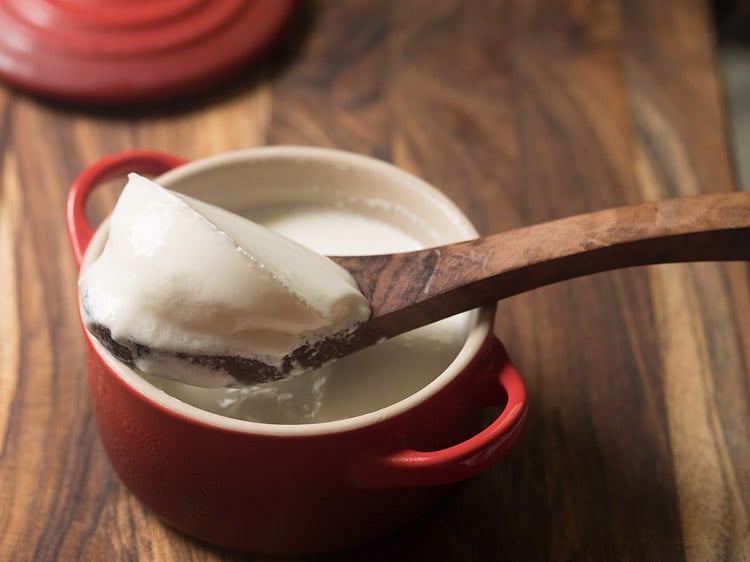
Serving & Storage
Have the curd plain as is or with sugar. Use it to make desserts, beverages or any other dish. You can also have a small bowl of curd with your lunch. I have listed below the varies ways you can consume curd.
As soon as the curd is set and fermented perfectly, place it in the refrigerator. Cover the bowl or pan with lid while refrigerating. Homemade dahi keeps well in the fridge for 4 to 5 days.
Expert Tips
- Milk: To have the best results at home, use full cream or whole milk that will yield in thick, luscious, creamy curd. You could use pasteurized or homogenized milk or farm fresh raw milk. Depending on the quality of milk, you may need to add less or more of the curd starter. Note that using toned milk or low fat milk, may yield thin or watery curd.
- Heating Milk: Before beginning with the curd making process, always boil the milk. This makes sure that the milk doesn’t spoil during fermentation.
- Temperature of Milk: Don’t use very hot milk. It may coagulate and result in a grainy product. If the milk is a little hot, the curd will not be thick, is a bit runny with some whey in it. With cold milk, it will not set properly.
- Right Temperature: The milk must be just warm. Check by dipping your little finger in it. It should feel warm, and not hot.
- Mixing: Ensure that the culture is dissolved uniformly in the milk. A spoon or whisk can be used to mix well.
- Scaling: To make thick curd, use any quantity of milk. For ½ liter milk, use 1 to 2 teaspoons of culture. Increase proportionally for larger quantities.
- Storing: You must refrigerate the curd once it is set properly.
Tips to make curd in cold weather
- If you stay in a place with cold weather conditions, cover the bowl/pan of the curd mixture with a warm towel/blanket and keep in a warm place in the kitchen.
- You can also use the Instant Pot yogurt function for making curd.
- You may also place the bowl/pan in a big jar of wheat flour and cover the jar. My mother-in-law makes curd this way in the Delhi winters.
- Remember that the curd will set quicker in summers than in winters.
Uses of Curd
Generally, we have a small portion of curd with our home meals. The helpful bacteria in the curd helps to digest the food.
So, if you have indigestion issues, then you must start consuming curd in your lunch, on a regular basis. Avoid having it in dinner, as it can develop a cold in your system.
After making fresh dahi with this Curd recipe, you can use it to make a plethora of Indian snacks, mains and beverages like Chaas, Lassi, Dahi Vada, Papdi Chaat, Curd Sandwich, Curd Rice, Kadhi Pakoda and the likes.
Simple raitas can also be prepared with it and paired with your parathas, thepla, etc. With these flatbreads, you can also have plain yogurt.
This Dahi recipe will give you fresh curd which you can also use in marinades for tikka and biryani recipes. Some famous sweets that can be made with the use of Indian Yogurt are Shrikhand, Mishti Doi and Balushahi.
More How To Recipes To Try!
DIY & Collections
DIY & Collections
DIY & Collections
DIY & Collections
Please be sure to rate the recipe in the recipe card or leave a comment below if you have made it. For more vegetarian inspirations, Sign Up for my emails or follow me on Instagram, Youtube, Facebook, Pinterest or Twitter.
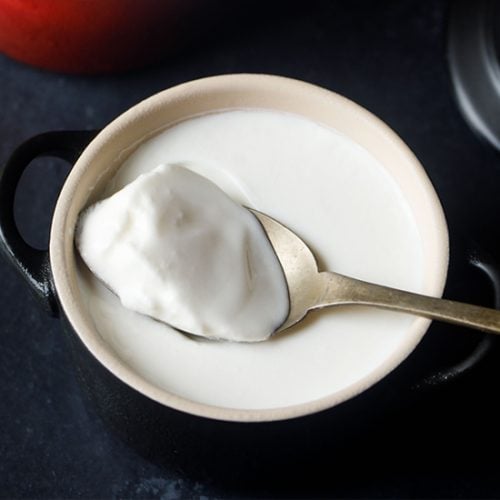
How To Make Curd | Dahi (Homemade Indian Yogurt)
Ingredients
- ½ litre whole milk
- 1 to 2 teaspoons Curd (dahi or yogurt) to be used as a starter
Instructions
Boil Milk
- Rinse a thick bottomed pan or saucepan with clean water.
- Pour milk into it and heat it on the stovetop on a medium-low to medium heat.
- Stir a couple of times when the milk is getting heated so that the milk does not get burnt from the bottom.
- When the milk comes to a boil, it will start rising. Before it spills out of the pan, switch off the heat. Set the pan aside on the kitchen countertop.
- Let the milk become warm at room temperature.
- To check if the milk has become warm dip your little finger (touch method) into the milk and you should feel warm and not hot. Second way is to touch the sides of the pan and it should feel warm and not hot.
- The third way is to check with a food thermometer and it should have a temperature between 39 to 44 degrees Celsius or 102 to 111 degree Fahrenheit.
- Once the milk has become warm, you can use the same pan for setting curd or transfer the warm milk in another bowl.
Make Curd
- Add 1 teaspoon of curd starter to the milk and mix thoroughly with a small wired whisk.
- Cover with lid and allow the milk to ferment for 5 to 6 hours or until the curd is set
- Depending on the temperature it may take more hours. You can also use Instant pot yogurt function to set the curd.
- On fermentation the curd will have a pleasant fermented aroma and with a slight tangy taste and it will also have a wobbly thick texture.
- Once the curd is made, refrigerate it so that it does not get overfermented.
- If you need sour curd for any recipe then keep the curd for a couple of hours at room temperature. This will lead to more fermentation and the curd will become sour or very sour.
- You can eat this curd with your meals. You can also add it to variety of recipes like curd rice, buttermilk, lassi, kadhi, mor kuzhambu, dahi kabab, dahi vada, dahi bhalla, biryani, paneer tikka or make raita with it.
Storage
- As soon as the curd is set and fermented well, place it in the refrigerator covered with a lid. Use a clean dry spoon to remove the curd and place the bowl or container back in the fridge.
- Homemade yogurt or dahi keeps well in the fridge for about 4 to 5 days.
Notes
- Use whole milk as it makes for a thick creamy curd.
- In hot Indian summers, this method works for me. Use pasteurized milk or raw milk that has been boiled earlier and which is refrigerated. Remove this cold milk from the fridge, mix the starter with it. Cover the bowl and let the mixture ferment for 5 to 6 hours or as needed. This saves a bit of time as you don’t need to heat the milk. But note that this method only works in a hot or warm climate. Please don’t use this method with raw milk or milk that has not been pasteurized or boiled earlier as it may have some harmful microorganisms. These microorganisms are destroyed when the milk is boiled.
- Make sure that the milk is warm before you mix the starter. Hot milk will kill the bacteria in the starter and you won’t get a properly fermented curd.
- In winters or cold climates ensure that you are not adding curd culture to milk that has cooled down. If the milk is cold, then the curd won’t set at all in the winters.
- It is very important to dissolve the curd culture uniformly in the milk. Whisk very well with a spoon or a wired whisk.
- Once the curd is set then refrigerate for a couple of days.
- To keep the starter ongoing remove a few spoons from the curd and either refrigerate or freeze it in a small covered bowl.
- If you don’t have any starter then buy packaged starters available in health stores or online stores or supermarkets.
- The recipe can be scaled. You can make a small amount or big batch according to your needs.
Nutrition Info (Approximate Values)
This Indian Yogurt Recipe from the archives was first published in May 2012. It has been updated and republished in February 2024.
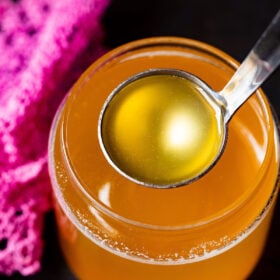
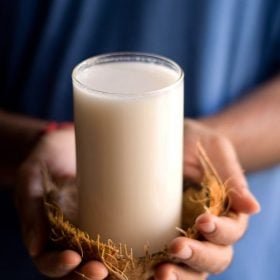
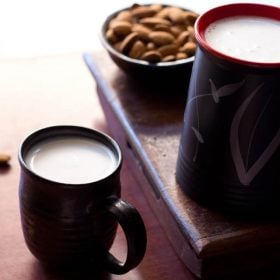
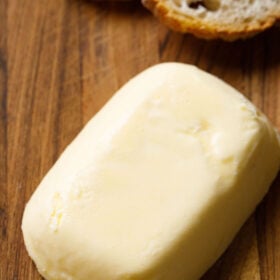
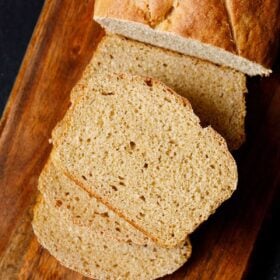
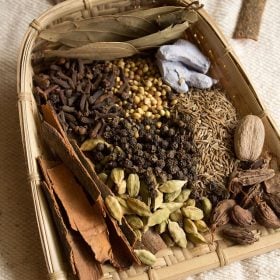
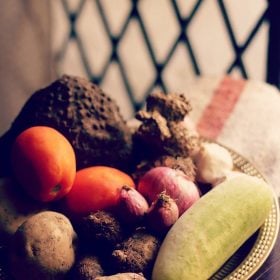








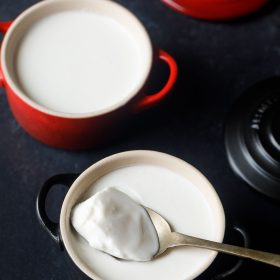
Hi Dassana,
Do you use non homogenized milk? My curd sets but there is so much whey in it. Your curd photo looks so thick and creamy without any whey. How to minimize whey in curd?
shubha, i use homogenised milk and do not have any problem with getting whey in curd. firstly in summers, do not keep the curd for a long hours as then the whey separates. secondly add less amount of the starter in summers. so for half a litre of milk, you can add 1 teaspoon of curd starter. too much of starter can also lead to the whey getting separated once the curd sets. do make sure that the milk is not hot. the milk has to be warm. you can even use cold milk and add the starter and keep for setting in these hot summers. the curd sets very well and is thick. no need to heat milk. if the milk is pasteurized or has been boiled earlier and refrigerated and then it can be used. hope this helps.
Hi Dassana,
Thanks so much for getting back. I keep my curd in the Instant Pot so it is independent of outside temperatures. I will monitor the heat of milk better when I add it to the bowl containing a teaspoon of the culture and see if that helps. The milk is pasteurized so maybe I can try to keep it cold.Thanks for your tips.
Welcome Shubha
Thank you u sharing me, i will try today ????
Dear Dassana
This is Arusha again….I have tried nearly 10 to 15 times but my milk does not set at al to turn into Dahi….I boiled milk in micro, on electric stove top and in different vessels also, like for micro I used pyrex bowl and for stove top I used steel vessel..but never I succeeded….In india my dahi sets in few hours but here, in the US it never happens..I have used full fat, 2 percent, whole milk…but did not get good dahi.can u give temperature in degrees, so I can try… do u think vessles make any difference in setting dahi??
arusha, i will update in a two days the temperature settings on this post. i just made dahi yesterday. i use steel pan for heating. i even use clay pot at times for heating milk. keep the bowl or pan in a warm place. also the outside temperature has to be warm or hot. in cold seasons setting dahi can be tricky. usually i cover the pan with a warm napkin or a towel and keep it in a warm corner of the kitchen. do not keep in a place where there is cold draft of air coming through. my mother in law keeps the pan in a large container (dabba) of atta. atta is warm and it helps in setting dahi easily.
Can you please tell us what yogurt this is most like? I’m trying to buy some yogurt starter for a better batch. Also could you explain how you use the yogurt to make paneer? No one sells a kit like that but I feel it would Sell Well! Thank you
what is sold in the west as yogurt is different than what we make in india as curd. curd has a pleasant sour taste and is not very thick. of course one has to taste curd made with the right strain of bacteria. what is sold even in indian markets as curd has a different taste as compared to the ones made in homes.
without a culture also you can make curd, but you need to have a nice warm climate. what i do is, i heat milk till its slightly hot. just a bit above being warm. then remove the crowns of green chilies, about 10 to 12 crowns. place the crowns on the milk. cover and keep. this method needs a warm room temperature and won’t work in a cool or cold climate. it takes 7 to 9 hours for the curd to set. you can also use dry red chili crowns. once the curd is set, then keep a few teaspoons of it in the fridge or freezer and then use this culture to make the second batch of curd with the method mentioned in this recipe post.
for paneer, once the milk comes to a boil, add 3 to 4 tablespoons of curd. stir well and the milk will split. you may need to add more if the milk does not split.
Hi Dassana,I have been making curd for quite some time now, but I follow a slightly different process. The glass bowl in which I intend to set the dahi, i smear the curd culture in that nicely like a coating, and then I pour the warm milk in it, and let it dry overnight in a corner of my kitchen. The curd comes out fine. I have never done it your way, but would try it and let you kNow. By the way, why is it that after repetitively using the curd culture from the same store bought curd cup, on the 4th or 5th time , the curd eventually doesn’t set as well as the 1st time?? Also have you ever prepared Greek yogurt??
Thanks
chayanika, thanks a lot for sharing this suggestion. i have always stirred the curd culture in the milk. i liked your method. i also sometimes just add green chili or red chili crowns in warm milk and let the curd set. this i do, when i do not have curd culture.
i have never faced this issue. in fact as time progresses, the curd sets very well. thats whats i have seen with the store brought curd.
i do make hung yogurt. its basically greek yogurt only but with a different name. i have shared the detailed method for making hung yogurt on the blog.
I used Amul milk to make curd.The curd does not set thick.There is a whey liquid on top.I am in Mumbai but even after 8 hours the curd had not even started setting it took 11 hours to set.
Is it because of the milk?
thats too long. at times i also use amul milk to set curd and it turns perfectly fine. just warm the milk a little more. also add green or red chili crowns on the milk. for green chilies, just rinse the chilies first and then remove the crowns from them and add in milk. you will get thick and creamy curd. at times i only use the chili crowns for setting curd when there is no starter.
Though the starter curd I used was Amul Dahi from the store, this is my third attempt and pretty much the same
Hi,
There is an issue that I am facing constantly(a newbie tp setting curd, though). We use buffalo milk here. However, even though the curd sets into a very thick, cream-ish(should it be creamy-ish??) consistency and tastes like curd, it is slightly sticky. Why? I use the above mentioned proportions. I stay in Mumbai. It is pretty humid here, as you might know. I set the curd overnight. I tried it in an earthern pot and even the one in which I boil milk. If Ieft outside it does start to turn sour-ish but not crazily though(like some homemade curds do). Also, my starter curd was Amul Dahi bought from the market. And ya, do I remive the malai/cream layer from milk before setting or not?(any which ways not a drastic improvement have i noticed). Do let me know where am i going wrong. The curd remains just too fresh for my liking(we like it a little bit sour). Help?
the stickiness is due to amul dahi being used as a starter. most readymade dahi brands add pectin to thicken the curd. so when you make curd with a store brought curd the curd will be slimy and stringy. if you keep on making curd with the reserved portion of the set curd every time, then the stickiness will go away eventually. for sourness, just keep for a few more hours. the creamish color will be due to the type and quality of milk.
Thanks.. It was all actually from the starter. I got one from the local halwai and the dahi/curd sets like a dream. ? Never going for store bought curd as starter.
Also, just out of curiousity_ sometimes there will be some whey liquid floating on top when I check my curd in the morning. Is it because it has been kept out that long, say 7-8 hrs and its d monsoon time here? And sometimes grainy/gritty(but not too much to worry about). Just wanted to know why??
i agree. the halwai folks have fresh curd without the addition of pectin or preservatives. the whey is seen if the curd is kept too long or the milk is slightly more hot and not warm. the graininess is due to the slight curdling that happens when curd is added to milk. this happens when the milk is hot. if the milk is warm, then no curdling will happen.
And, ya..is there a different way to set curd in an earthen or mitti ka bartan?
there is no different way. before using the earthen bowl you need to soak the it for some hours with water. then let it dry naturally or you can dry in sunlight too. then pour the warm milk+curd mixture in it. cover and let it set.
Hi..I wish to know the recipe for setting curds with lemon juice? Coz lemon juice is more readily available than a teaspoon of home-set curd, and ready made curd just doesn’t help ..So if u could pls give the ingredients as well as the recipe for setting curds with lemon juice(measuring cup etc also will be useful information..)..thanx a lot
Nyati Singh
i have not read or know any method where curd can be set with lemon juice. you do need a starter to set the curd. one way is to use green chilies crowns to set curd. warm milk. add green chili crowns. keep in a warm place. cover and let the curd set. this will take more time than setting the curd with a starter. try first with 1 cup of milk. then you can use the curd starter for setting curd later. for 1 cups of milk, you can add 4 to 5 green chili crowns.
Hey,
I use Amul cow’s milk and whenever I try to set the curd it becomes very sticky. What can be the reason, it looks really ugly.
which curd starter you use. do you use readymade curd starter like amul or any britannia. with readymade curd starters, the curd when set becomes stringy and sticky. over a period of time, if you keep on taking the curd starter from the previous batch of curd you have made, then the stringiness and stickiness goes away. but this means that you have need to have many batches of curd with the same starter.
Yes, i have tried 3-4 times with Nestle’s curd and everytime it gets sticky i stop using it thinking that milk has some issue. But thanks for your suggestion I will follow it till i get the desired curd.
And yes, yesterday’s hakka noodles were good but were a little dry, i used 4-5 spoons of oil, not sure why the dryness.
fine neha. if you have a generous neighbor, then you can use the curd starter from them 🙂
its not due to the milk. its the ready curd starter as they add pectin and thats why the stringy slimy consistency is there once the curd is set. thanks for the feedback on hakka noodles. dryness could be due to less sauce or the veggies must have got sauteed to much.
Can I use store bought Kefir yogurt drink as a starter? Thank you!
i am not sure as i have never used kefir yogurt drink. you can give a try and make a small batch of curd.
curd and yoghurt are not the same things. They have different bacteria in them. You might want to correct your article.
technically what you say is right, but in india curd and yogurt are used synonymously. hence i have used the word yogurt. in my college the english translation of ‘dahi’ or ‘curd’ would be yogurt.
dear madam, mmm For last 60 yrs i am using same procedure to prepare curd.For last 6 months this mode fails.Usually i collect thick layer milk cream in a bowl and mix in it 2 tablespoon of curd thouraly.In the same bowl i put cream twice a day and stir well for 4 to 5 days.There i found a layer of white bacillus visible to naked eyes.I learnt bacteria forming curd from milk are invisible to naked eyes.What is the reason for the appearance of a layer of white bacillus on the top of bowl? Can i use this curd?What precaution to take safe curd ?Thanking you.
the bacteria are invisible to the eyes. from what you say, you are keeping the mixture for 4 to 5 days at room temperature. looks like the curd is getting spoiled. please don’t use it.
Dear Dassana,
I’ve been making curd for a long time now. But since I came to africa, my attempts to make curd is never successful. Last night a tried once again, but there is a bitter taste to the curd. Do u have any idea what went wrong?
the curd has not set well or has got spoiled. discard it. when curd does not set properly or gets spoiled, there is a bitter taste. so don’t use this curd.
King mangarasa III of mid 15th century wrote a book on south Indian culinary, which is “Supa sastra.” In this book he stated 20+ ways to set curd. Each resulting in different texture and taste.
If you can buy translated very of this book online
thanks madhusudhan for sharing this info. i didn’t knew about it.